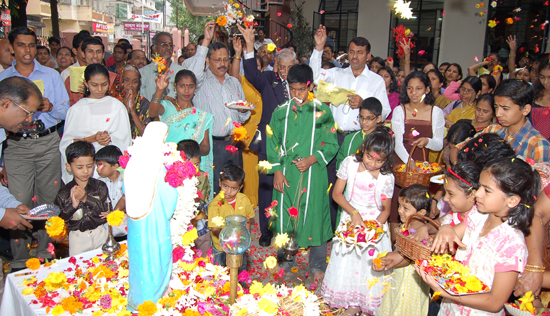 Mangaloreans partaking in the occasion of Monti Fest at Poona (Pune). | |
| Regions with significant populations | |
|---|---|
| Diocese of Mangalore | 360,000[1] |
| Diocese of Udupi | 106,000 (approx) |
| Languages | |
| Konkani, Tulu, Kannada, Hindi-Urdu, Indian English, and Bombay Mahratti | |
| Religion | |
| Latin Church | |
| Related ethnic groups | |
| Kudali Catholics, Goan Catholics, Karwari Catholics, Bombay East Indian Catholics, Damanese Catholics, Mangalorean Protestants, Latin Catholics of Malabar, Koli Christians, Kunbi, Maratha, Gaodi Christians, Christian Brahmins, Christian Cxatrias, Saraswat Brahmins, Daivadnyas, Vaishya Vanis, Anglo-Indians and Luso-Indians | |
Mangalorean Catholics (Konkani: Kōdiyālcheñ Kathōlikā) are an ethno-religious community of Latin Christians from the Diocese of Mangalore and the erstwhile South Canara area, by the southwestern coast of present-day Karnataka, India.[2][3]
Contemporary Mangalorean Catholics descend mainly from the New Christians of Portuguese Goa, who migrated to the Keladi Kingdom 1560-1763,[4][5] throughout the courses of the Goan Inquisition, the Portuguese–Adil Shahi War & the Mahratta Invasion of Goa and Bombay.[6][7] They learned Tulu and Kanarese whilst in Canara, but retained the Konkani language and preserved much of their Konkani way of life, which had undergone Christianisation in Goa. The "Canara Christians" faced a 15-year-long captivity at Seringapatam, imposed by Tippu Sultan.[8] Following Tippu's defeat and death at the Siege of Seringapatam (1799) by the English East India Company, the Nizam of Hyderabad & other allies; most of them resettled in and around South Canara; also areas such as Chikmagalur (Chickmangalore) & Coorg (Kodagu) during the Company rule in India. A lesser number shipped to the Seven Islands of Bombay & the Bombay metropolitan area in the northern Konkan region.
In the early 20th century, there were more migrations of the educated and working classes to bigger cities such as the Bombay (Mumbai), Poona (Pune) & Bangalore (Bengaluru); this led to the formation of a Mangalorean diaspora in the Persian Gulf countries and the Anglosphere;[9] thus the younger generation outside of South Canara, is mostly an English-speaking anglo-americanised Konkani sub-culture. Also, intermarriages with non-Mangaloreans has caused a decline in "Mangalore stores" and the culture of Mangalorean Catholic cuisine.[10]
- ^ Cite error: The named reference
MDwas invoked but never defined (see the help page). - ^ Pai & Supriya 1981, p. 203: "This city (Mangalore) has a very influential proportion of Roman Catholics, numbering over a good quarter of the total population. It is the seat of the Diocese of Mangalore, a Latin Church jurisdiction, and hence when we speak of the Mangalorean Catholics, we do not limit ourselves only to the roughly 60,000 Catholics within the city limits, but to a total of much over 200,000 Catholics spread over the whole diocese, which is co-terminous with the civil district of South Kanara."
- ^ Farias 1999, p. 299: "Four centuries of living in South Kanara gave these Catholics an identity of their own. Thus they are commonly known as Mangalorean Catholics."
- ^ "125 years and still growing". Archived from the original on 26 September 2024.
- ^ "Full History - Milagres Church". Archived from the original on 26 September 2024.
- ^ "Monti Fest: Feast of the Nativity of Blessed Virgin Mary: The Cultural Identity of Konknni Catholics - Daijiworld.com". 26 September 2024. Archived from the original on 26 September 2024. Retrieved 4 October 2024.
- ^ "Did Shivaji think of conquering 'Portuguese' Goa?". 22 February 2020. Archived from the original on 9 April 2022.
- ^ The Captivity of Canara Christians Under Tippu in 1784, Etc. 1933.
- ^ Cite error: The named reference
:1was invoked but never defined (see the help page). - ^ "Mumbai's Mangalore stores are slowly dying". Archived from the original on 22 September 2024.